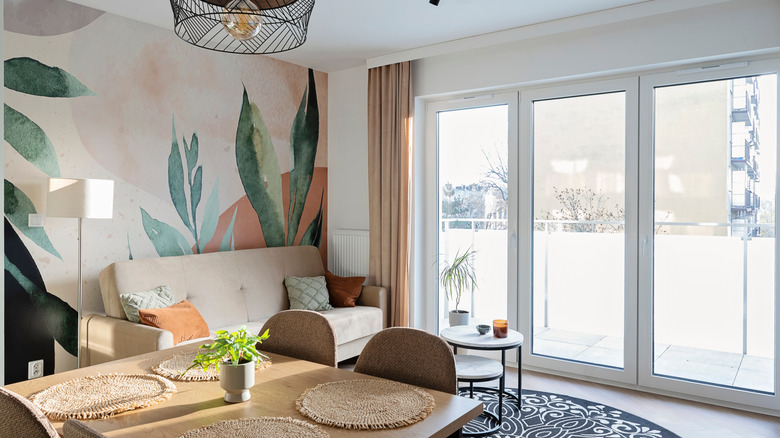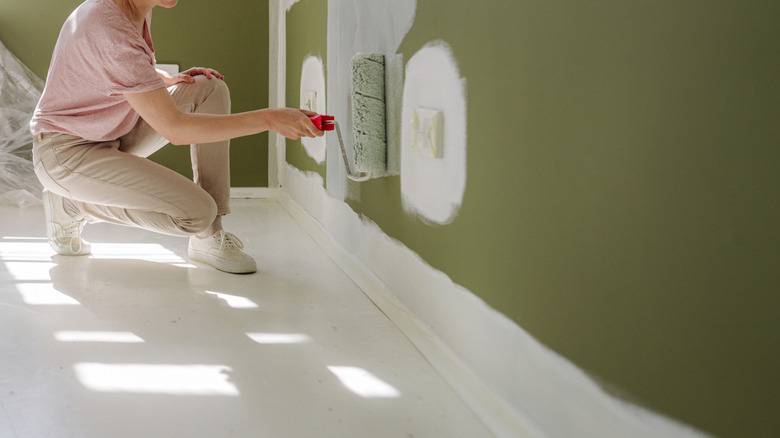Leave Wallpaper Behind & Try A Budget-Friendly DIY To Transform Your Walls Instead
There are plenty of entryway, bedroom, home office, bathroom, and kitchen wallpaper ideas that will add charm to your home. While rolls of decorative paper will make your interiors pop, your wallet won't like them much. This is because covering a single room can cost as much as $2,000 or more if the area is large. DIYing it will help you save on labor, and dressing just one wall will bring down the overall costs significantly. But you may still have to shell out hundreds of dollars for one roll if you want a premium or personalized design. So, if you're on a tight budget, leave wallpaper behind and try a budget-friendly DIY instead. All you need is a stamp and a little paint to transform your walls.
You can go with mass-produced rubber stamps if you don't want to spend more than a few dollars. If you're on an incredibly tight budget, borrow a pretty one from your kids or neighbors. Alternatively, order a custom stamp for a special wall design. In case you want the best of both worlds, check out the arts and crafts section at your local thrift stores. However, if you have something very specific in mind, create your own stamp with craft foam and cardboard. You could even carve pretty designs in potatoes to avoid spending money. Just don't leave the carved ones out for a night, or they'll lose their firmness by morning, and you'll have a hard time imprinting the design onto your wall. Once you finalize the medium and design, it's time to prep the chosen surface and gather the required supplies for this DIY project.
Prep your walls for stamping and gather the required supplies
Start by wiping your walls clean for the paint to adhere well. Use a damp microfiber cloth to get rid of the built-up dust and dirt. If you're covering a surface in your kitchen, this step will take care of greasy residue, too. Now, assess the wall critically. Does it look smooth and stain-free? If not, apply a fresh coat of primer and let it dry before stamping. Pick the right type of primer when covering up nasty stains. However, if you don't like the current color, paint the wall anew. Just ensure that the base hue coordinates with the stamp shade you have in mind. Let the paint dry for at least four hours before pressing in pretty designs.
As for the supplies, a stamp is the key item. You'll also need a little paint. Choose leftover acrylic craft paint for a glowy or metallic appearance. Latex is another good option and will give you a soft finish. Spring for specialty paints if you want a textured look. Besides these, you'll require a level, measuring tape, paint stir stick, pencil, cheap paper plate or paint tray, and mini roller or foam brush. Basically, the same tools you need for a flawless home paint job. Additionally, keep a rag handy to take care of imperfections before the paint cures. If this sounds like too much work, substitute the paint and associated supplies with a stamp pad. The clean lines and unfussy finish will lend your wall an understated appearance.
How to stamp your walls for a wallpaper-like effect
Start by dividing your wall into small segments and deciding on the pattern of your stamps. Do you want to go with straight lines? Or, would you want to try a chevron design? You could go diagonal or pick herringbone. The choice is yours. In case you're confused, try out your favorite pattern on a poster board. Then, nail the spacing between the designs. Although you can eyeball this, don't give in to the temptation if you're not a pro DIYer and wouldn't want crooked lines to wreck your carefully chosen pattern. Mark the exact areas you'd want to stamp on your wall using a measuring tape and pencil.
Next, stir your paint with a dedicated stick, pour a little into a tray, and dip a mini roller inside. Don't saturate it since you don't want thick globs on your walls. Then, roll it evenly over your design. Alternatively, pour a tiny amount of paint on your plate. Spread it well and use a foam brush to apply paint over your stamp. Avoid dipping the stamp directly in the paint since this will lead to uneven patterns. Now, start stamping your wall. Be deliberate and keep your hand steady. Mix in two or more colors to add visual interest and lend your chosen theme some credibility. For instance, if you want to bring the fall season to your walls, gradually add the burnt reds and vibrant oranges to green leaves. Another idea is to move from a dark and visible pattern to a light version for a dramatic transition.

